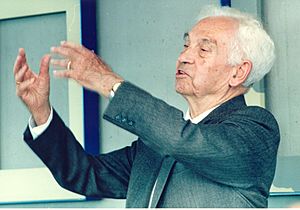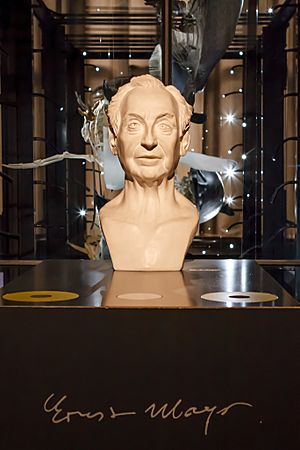Ernst Mayr facts for kids
Quick facts for kids
Ernst Mayr
|
|
|---|---|

Mayr in 1994
|
|
| Born |
Ernst Walter Mayr
5 July 1904 Kempten, Bavaria, German Empire
|
| Died | 3 February 2005 (aged 100) Bedford, Massachusetts, U.S.
|
| Nationality | German American |
| Alma mater |
|
| Awards |
|
| Scientific career | |
| Fields | Systematics, evolutionary biology, ornithology, philosophy of biology |
Ernst Walter Mayr (born July 5, 1904 – died February 3, 2005) was a very important biologist in the 20th century. He was a leading expert in evolutionary biology. He also studied how living things are grouped and named, which is called taxonomy.
Mayr was an explorer who studied birds, especially in tropical areas. He was also a philosopher of biology, meaning he thought deeply about the ideas behind biology. He also studied the history of science.
His work helped create the "modern evolutionary synthesis." This idea brought together Mendel's ideas about genetics (how traits are passed down) with Darwin's ideas about evolution. Mayr also helped develop the "biological species concept," which explains what a species is.
Before Mayr, scientists like Charles Darwin knew that new species could come from a single ancestor. But they didn't fully understand how this happened. This was known as the "species problem." Ernst Mayr offered a new way to define a species.
In his 1942 book, Systematics and the Origin of Species, he wrote that a species is not just a group of similar-looking individuals. Instead, it's a group of living things that can breed only with each other. They cannot breed with other groups.
When groups within a species become separated, for example, by geography, they might start to change. These changes can happen through genetic drift or natural selection. Over time, these differences can become so big that the groups evolve into new species. Mayr believed that the fastest changes happen in very small groups that are isolated, like on islands.
Mayr's idea of peripatric speciation is still a leading theory for how new species form. This idea came from his studies of birds. It also helped form the theory of punctuated equilibrium, proposed by Niles Eldredge and Stephen Jay Gould. Some people say Mayr invented modern philosophy of biology. He showed how evolutionary biology is different from physics because it includes the history of life.
Contents
Biography of Ernst Mayr
Ernst Mayr was born in Kempten, Germany. He was the second son of Helene Pusinelli and Dr. Otto Mayr. His father was a lawyer but loved nature. He often took his children on outdoor trips. Ernst learned about all the local birds from his older brother, Otto. He also read a nature magazine for young people called Kosmos.
When Ernst was almost 13, his father passed away. His family then moved to Dresden, where he finished high school. In 1922, while still in school, he joined a new birdwatching group. There, he met Rudolf Zimmermann, who became his guide in studying birds.
In 1923, Mayr finished high school. His mother gave him binoculars as a reward. On March 23, 1923, he saw a rare bird called a red-crested pochard. It hadn't been seen in Saxony since 1845. The local bird club debated if his sighting was real.
A club member suggested Mayr visit Erwin Stresemann, a famous ornithologist. Stresemann was very impressed with Mayr's knowledge. He offered Mayr a volunteer job in the bird section of the Berlin Museum. Mayr said this felt like "someone had given me the key to heaven."
Mayr started studying medicine at the University of Greifswald in 1923. He did this to follow a family tradition. But after only a year, he switched to biology. He chose Greifswald because it was a great place for birdwatching. He was always most interested in birds.
Stresemann gave Mayr a test to identify birds, and Mayr did very well. Stresemann said Mayr was a "born systematist" (someone who classifies living things). In 1925, Stresemann told Mayr to stop his medical studies. He suggested Mayr join the Berlin Museum and go on trips to collect birds in the tropics. But Mayr had to finish his doctorate in 16 months.
Mayr earned his doctorate in ornithology at the University of Berlin in 1926. He was only 21 years old. Soon after, he accepted a job at the museum.
In 1927, Mayr met Walter Rothschild, a banker and naturalist. Rothschild asked Mayr to go on an expedition to New Guinea. This trip was for Rothschild and the American Museum of Natural History in New York. In New Guinea, Mayr collected thousands of bird specimens. He discovered and named 26 new bird species during his life. He also named 38 new orchid species.
While in New Guinea, he joined the Whitney South Sea Expedition to the Solomon Islands. He also visited missionaries and found problems with a popular book by Hermann Detzner. Detzner had claimed to explore New Guinea's interior, but Mayr found his story was not true. Mayr returned to Germany in 1930.
In 1931, Mayr moved to the United States. He became a curator at the American Museum of Natural History. He helped the museum buy Walter Rothschild's huge collection of bird specimens. During his time at the museum, he wrote many papers on bird classification. In 1942, he published his first book, Systematics and the Origin of Species. This book helped complete the modern evolutionary synthesis.
Mayr also guided many young birdwatchers in America. He noticed that German bird societies were more focused on science. They studied bird life cycles and breeding habits more.
Mayr led a monthly seminar for the Linnean Society of New York. This group focused on classifying birds. Mayr encouraged his students to start their own research projects. One student, Joseph Hickey, wrote A Guide to Birdwatching (1943). Hickey remembered Mayr as a fun and engaging person.
Mayr also greatly influenced American ornithologist Margaret Morse Nice. He helped her connect with European bird experts. He also helped her publish her important two-volume study on song sparrows. Nice dedicated her book to "My Friend Ernst Mayr."
In 1953, Mayr joined Harvard University. He was also the director of the Museum of Comparative Zoology from 1961 to 1970. He retired in 1975 as a professor of zoology, receiving many honors. Even after retiring, he kept writing. He published over 200 articles and 14 of his 25 books after he turned 65. He continued writing books even when he was 100 years old.
Ernst Mayr passed away on February 3, 2005, at his home in Bedford, Massachusetts. He had married Margarete "Gretel" Simon in 1935. She helped him with some of his work. Margarete died in 1990. Mayr was survived by his two daughters, five grandchildren, and ten great-grandchildren.
Mayr received many important awards. These include the National Medal of Science, the Balzan Prize, and the Crafoord Prize. The Crafoord Prize honors research in fields that don't have Nobel Prizes. Mayr never won a Nobel Prize, but he pointed out that there is no Nobel Prize specifically for evolutionary biology.
Mayr's Scientific Ideas
Mayr was trained in traditional biology. He often disagreed with early mathematical ways of studying evolution. He called these methods "beanbag genetics" in 1959. He believed that factors like how species are prevented from breeding with each other were very important.
Mayr also didn't fully agree with studies of molecular evolution. He argued against reductionism in evolutionary biology. This is the idea that you can understand a complex system by breaking it down into its smallest parts. Mayr believed that evolutionary pressures affect the whole organism, not just single genes. He said that genes can have different effects depending on other genes present. He thought scientists should study the entire genome (all the genes), not just isolated ones.
After he introduced the biological species concept in 1942, Mayr was central to the "species problem" debate. This debate was about finding the best way to define a "species." He strongly defended his biological species concept against many other definitions.
Mayr was a strong supporter of the scientific method. He was known for criticizing science that he felt was not well-supported. For example, in 1995, he criticized the Search for Extra-Terrestrial Intelligence (SETI). He thought it was a waste of resources because it couldn't answer a scientific question. Over 60 famous scientists, led by Carl Sagan, disagreed with his criticism.
Species Named in His Honor
Many living things have been named after Ernst Mayr to honor his contributions to biology. Here are a few examples:
- Bismarck black myzomela (Myzomela psammelaena ernstmayri) – a type of honeyeater bird found on small islands near New Guinea.
- Mayr's forest rail (Rallicula mayri) – a bird species found in New Guinea.
- Mayr's honeyeater (Ptiloprora mayri) – another bird species from New Guinea.
- Mayr's swiftlet (Aerodramus orientalis) – a bird species found in New Ireland and Guadalcanal.
- Ernst Mayr's water rat (Leptomys ernstmayri) – a type of rodent found in New Guinea.
- A roundworm called Poikilolaimus ernstmayri.
- The extinct New Ireland rail (Gallirallus ernstmayri) – a large, probably flightless bird known from fossils in New Ireland.
- The Star Mountains worm-eating snake (Toxicocalamus ernstmayri) – a rare, venomous snake from New Guinea that eats earthworms.
- An assassin bug called Bagauda ernstmayri.
- A genus (group) of pseudoscorpions named Ernstmayria.
- A spider species, Cebrennus mayri.
- A damselfly species, Palaiargia ernstmayri.
- A bird lice species, Anaticola ernstmayri.
- An earwig species, Irdex ernstmayri.
Understanding Darwin's Theory of Evolution
Ernst Mayr helped explain Darwin's theory of evolution. He summarized it using key facts and what we can guess from those facts:
- Every species can have enough babies that if all of them survived, the population would grow very fast (a fact).
- But, populations usually stay about the same size, even with small changes (a fact).
- Resources like food are limited and don't change much over time (a fact).
- Because of this, living things must struggle for survival (a guess based on the facts).
- Individuals within a population are very different from each other (a fact).
- Many of these differences can be passed down from parents to children (heritable) (a fact).
- Individuals that are not as well-suited to their environment are less likely to survive and have babies. Individuals that are better-suited are more likely to survive and pass on their helpful traits. This process is called natural selection (a fact).
- This slow process makes populations change over time to fit their environments better. Eventually, these changes build up and form new species (a guess based on the facts).
Mayr also pointed out how Darwin's book On the Origin of Species changed how people thought:
- It showed that the world is always changing, not staying the same.
- It made the idea of creationism (that life was created exactly as it is) seem unlikely.
- It challenged the idea that the universe has a special purpose.
- It showed that humans are not necessarily the center of the world.
- It explained that natural processes can make things look designed.
- It introduced "population thinking," which means looking at groups of individuals rather than perfect "types."
See also
 In Spanish: Ernst Mayr para niños
In Spanish: Ernst Mayr para niños
- American philosophy
- Biosemiotics
- Evolution
- List of American philosophers
- List of centenarians (scientists and mathematicians)
- Species Problem
- Philosophy of biology
- Proximate and ultimate causation


